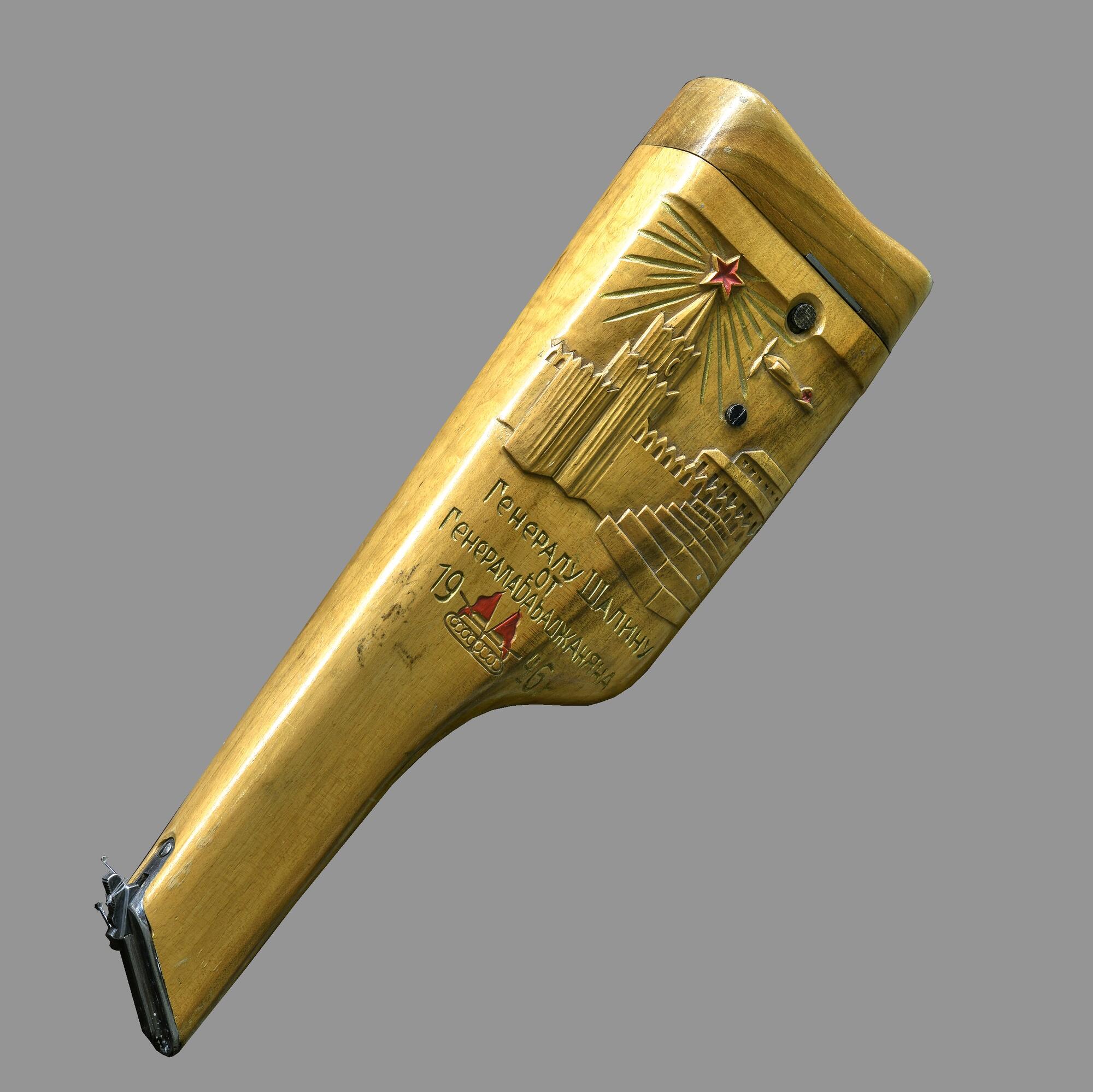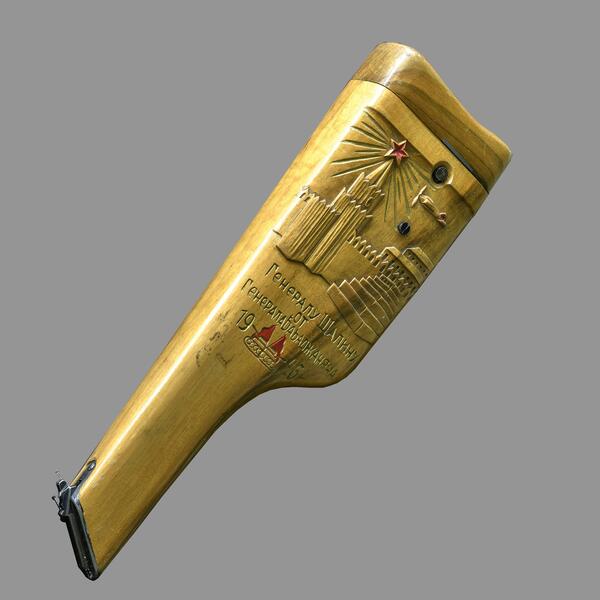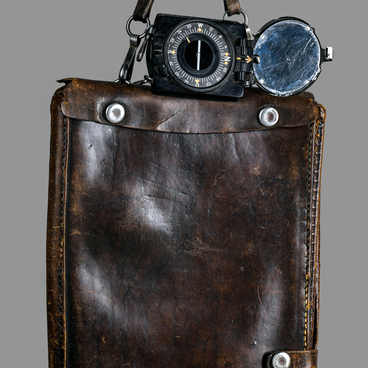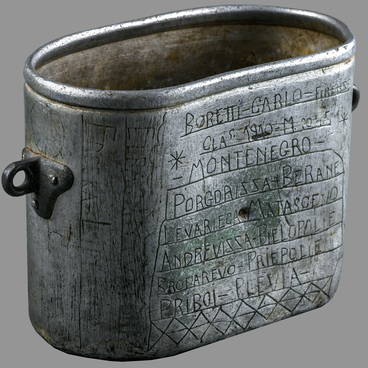The Mauser self-loading pistol was developed in Germany in 1895. The holster stock allowed for more effective shooting. In Russia, the Mauser pistol was used during the Civil War and around 30,000 were ordered for the Red Army in the 1920’s which remained in use by commanding officers until the end of 1939. The exhibition includes a version of the holster given as a gift. It has wooden carvings and a dedication: ‘To General Shalin from General Babadzhanian. 1946.’
Mikhail Alekseevich Shalin (1897-1970) was born in the village of Kumak, Orsk district. He graduated from the Orsk 4-grade city school, the Orenburg Teacher Training college. In 1916, he entered into military service. After completing an abbreviated training course at the Vilna infantry school, he earnt the rank of warrant officer and served as a division commander in a reserve regiment. From 1918, he served in the Civil War in the Red Army, eventually reaching the rank of Brigade Commander.
In 1936, he graduated from the Frunze Military Academy and was sent to the military intelligence wing of the army. He served as chief of staff for the 1st Guards Tank Division during the Great Patriotic War. He fought in the following battles: Battle of Kursk, Belgorod-Kharkov Offensive Operation, Zhitomir–Berdichev Offensive, Proskurov-Chernovtsy Offensive, Lvov–Sandomierz Offensive, Vistula–Oder Offensive, East Pomeranian Offensive and Battle of Berlin. Shalin’s service in his post was highly regarded by commanding officer Mikhail Efimovich Katukov: ‘I was fortunate to have Mikhail Alekseevich Shalin as a Chief of Staff. Before the war he worked as a military attaché in Tokyo. He was extraordinarily hard-working. As a staff officer he was precise and accurate to the point of pedantry. Whatever time you visited the headquarters, he was always at his desk. He would stroke his shaved head and work some magic on his maps or papers. I was always able to rely on him: Shalin considered everything. He left no stone unturned.’ This part of the army included the 11th Guards Tank Regiment, commanded by General Hamazasp Khachaturi Babadzhanian.
After the end of the war, Hamazasp Khachaturi Babadzhanian continued to command the regiment, which was reorganized into the 11th Guards Tank Division in July 1945. Between 1946 and 1949, Mikhail Alekseevich Shalin managed the Soviet Army’s military-diplomatic academy. Shalin’s later career would develop as follows: in 1949, he was appointed Chief of the first Deputy-Directorate, in 1951 he was appointed deputy Head of Second Main Intelligence Directorate GRU, General Staff of the Soviet Army. From July 1952, he was appointed Head of Second Main Intelligence Directorate, General Staff, from October 1952 until August 1956 he served as Head of Main Intelligence Directorate GRU, General Staff. His Military rank was Colonel-General. From October 1957 until December 1958 he once again managed the GRU, General Staff.
In 1936, he graduated from the Frunze Military Academy and was sent to the military intelligence wing of the army. He served as chief of staff for the 1st Guards Tank Division during the Great Patriotic War. He fought in the following battles: Battle of Kursk, Belgorod-Kharkov Offensive Operation, Zhitomir–Berdichev Offensive, Proskurov-Chernovtsy Offensive, Lvov–Sandomierz Offensive, Vistula–Oder Offensive, East Pomeranian Offensive and Battle of Berlin. Shalin’s service in his post was highly regarded by commanding officer Mikhail Efimovich Katukov: ‘I was fortunate to have Mikhail Alekseevich Shalin as a Chief of Staff. Before the war he worked as a military attaché in Tokyo. He was extraordinarily hard-working. As a staff officer he was precise and accurate to the point of pedantry. Whatever time you visited the headquarters, he was always at his desk. He would stroke his shaved head and work some magic on his maps or papers. I was always able to rely on him: Shalin considered everything. He left no stone unturned.’ This part of the army included the 11th Guards Tank Regiment, commanded by General Hamazasp Khachaturi Babadzhanian.
After the end of the war, Hamazasp Khachaturi Babadzhanian continued to command the regiment, which was reorganized into the 11th Guards Tank Division in July 1945. Between 1946 and 1949, Mikhail Alekseevich Shalin managed the Soviet Army’s military-diplomatic academy. Shalin’s later career would develop as follows: in 1949, he was appointed Chief of the first Deputy-Directorate, in 1951 he was appointed deputy Head of Second Main Intelligence Directorate GRU, General Staff of the Soviet Army. From July 1952, he was appointed Head of Second Main Intelligence Directorate, General Staff, from October 1952 until August 1956 he served as Head of Main Intelligence Directorate GRU, General Staff. His Military rank was Colonel-General. From October 1957 until December 1958 he once again managed the GRU, General Staff.



